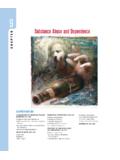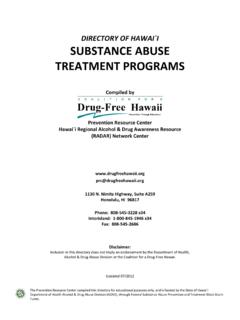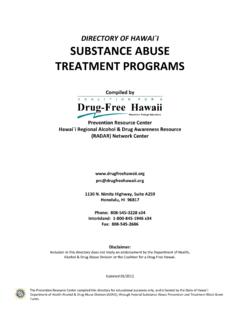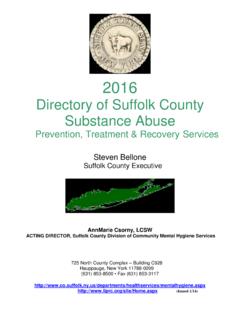Transcription of Neuroscience of Psychoactive Substance Use and …
1 Neuroscienceof Psychoactive SubstanceUse and DependenceSUMMARYW orld Health OrganizationGenevaWHO Library Cataloguing-in-Publication DataNeuroscience of Psychoactive Substance use and dependence : Psychotropic drugs - pharmacology 2. Substance -related disorders -physiopathology3. Psychopharmacology4. Brain - drug effectsI. World Health 92 4 159124 2(NLM classification: WM 270)QWorld Health Organization 2004 All rights reserved. Publications of the World Health Organization can be obtained fromMarketing and Dissemination, World Health Organization, 20 Avenue Appia, 1211 Geneva 27,Switzerland(tel: +41 22 7912476; fax: +41 22 791 4857; email: Requestsfor permission to reproduce or translate WHO publications --- whether for sale or fornoncommercial distribution --- should be addressed to Publications, at the above address (fax:+41 22 791 4806; email: designations employed and the presentation of the material in this publication do not implythe expression of any opinion whatsoever on the part of the World Health Organizationconcerningthelegalstatusofan ycountry,territory,cityorareaorofitsauth orities,orconcerningthe delimitation of its frontiers or boundaries.))
2 Dotted lines on maps represent approximateborder lines for which there may not yet be full mention of specific companies or of certain manufacturers products does not imply thatthey are endorsed or recommended by the World Health Organization in preference to others ,thenamesofproprietaryproducts are distinguished by initial capital World Health Organization does not warrant that the information contained in thispublication is complete and correct and shall not be liable for any damages incurred as a result ofits in SwitzerlandContentsForeword5 Acknowledgements6 Introduction7 Global use of Psychoactive substances and burden to health8 Tobacco use8 Alcohol use8 Illicit Substance use9 Burden of disease10 Adverse consequences of Psychoactive substancesand their mechanisms of action12 Substance use and dependence in relation to neuroscience12 Neuroanatomy, neurobiology.
3 And pharmacology13 Brain mechanisms15 Psychopharmacology of dependence for different Substance classes17 Neurobiological and biobehavioural basis ofthe development of Substance dependence20 dependence as a learning process involving key brain regions20 Biobehavioural processes underlying dependence20 Mesolimbic dopamine pathway20 Motivation and incentive21 Genetic basis of individual differences in susceptibilityto Substance dependence22 Comorbidity of Substance dependence and mental illness25 Treatment and prevention: links with Neuroscience , and ethical issues26 Types of treatment26 Ethical issues in Neuroscience researchon Substance dependence30 Ethics and types of Neuroscience researchon Substance dependence30 Conclusion and implications for public health policy32 References343 ForewordSubstance use and dependence cause a significant burden to individuals andsocieties throughout the world.
4 The World Health Report 2002 indicated that ofthe total burden of disease comes from the use of Psychoactive substances. Thereport showed that tobacco accounted for , alcohol 4%, and illicit drugs ofthe burden of disease in 2000. Much of the burden attributable to Substance use anddependence is the result of a wide variety of health and social problems, includingHIV/AIDS, which is driven in many countries by injecting drug neurosciencereport is the first attempt by WHO toprovide acomprehensiveoverview of the biological factors related to Substance use and dependence bysummarizingthe vast amountof knowledge gained in the last 20-30years. Thereporthighlights the current state of knowledge of the mechanisms of action of differenttypes of Psychoactive substances, and explains how the use of these substances canlead to the development of dependence the focus is on brain mechanisms, the report nevertheless addresses thesocial and environmental factors which influence Substance use and dependence .
5 Italso deals with Neuroscience aspects of interventions and, in particular, the ethicalimplications of new biological intervention various health and social problems associated with use of and dependenceon tobacco, alcohol and illicit substances require greater attention by the publichealth community and appropriate policy responses are needed to address theseproblems in different societies. Many gaps remain to be filled in our understanding ofthe issues related to Substance use and dependence but this report shows that wealready know a great deal about the nature of these problems that can be used toshape policy is an important report and I recommend it to a wide audience of health careprofessionals, policy makers, scientists and Jong-wookDirector GeneralWorld Health Organization5 AcknowledgementsThis summary was prepared by Franco Vaccarino and Susan Rotzinger of the Centrefor Addiction and Mental Health, Toronto, Canada, with contributions from IsidoreObot and Maristela Monteiro.
6 Vladimir Poznyak and Nina Rehn helped with theiradvice and comments. Mylene Schreiber and Tess Narciso provided logisticalsupport throughout the preparation and publication of the World Health Organization also acknowledges the contributions of thefollowing individuals to the book on which this summary is based:Helena M. T. Barros,Lucy Carter, David Collier, GaetanoDi Chiara, Patricia Erickson,Sofia Gruskin, Wayne Hall, Jack Henningfield, Kathleen M. Kantak, Brigitte Kieffer,Harald Klingemann, Mary Jeanne Kreek, Sture Liljequist, Rafael Maldonado,Athina Markou, Gina Morato, Katherine Morley, Karen Plafker, Robin Room,Andrey Ryabinin, Allison Smith, Rachel Tyndale, Claude Uehlinger, Frank Vocci,and David report has been produced within the framework of the mental health GlobalAction Programme (mhGAP) of the Department of Mental Health and SubstanceAbuse, World Health Organization, under the direction of Benedetto report describes the current understanding of the Neuroscience of psychoactivesubstance use and is concernedwith all of the functionsof the nervous system, particularly the brain.
7 Psychoactive substances have theability to change consciousness, mood, and thoughts. This report draws on theexplosive growth in knowledge in Neuroscience in recent decades, which hastransformed our understanding of the actions of Psychoactive substances, andcontributed new insights into why many people use Psychoactive substances, andwhy some use them to the extent of causing themselves harm or of need for this report comes from these advances in Neuroscience research,which have shown that Substance dependence is a chronic, relapsing disorder with abiological and genetic basis, and is not simply due to lack of will or desire to treatments and interventions for Substance dependence do exist, andinvolve both pharmacological and behavioural interventions. The stigma associatedwith Substance use and dependence can prevent individuals from seekingtreatment, and can prevent adequate policies regarding prevention and treatmentto be implemented.
8 A WHO study of attitudes to 18 disabilities in 14 countries foundthat Substance addiction ranked at or near the top in terms of social disapproval orstigma, and that alcoholism ranked not far behind in most of the societies studied(1). Neuroscience -based knowledge of Substance dependence affords an oppor-tunity to clarify misunderstandings, and to eliminate incorrect and report covers information on the global burden of Substance use anddependence, including global statistics, individual and societal consequences of theacute and chronic use of Psychoactive substances, and illustrates the pervasiveeffects of Substance dependence throughout the world. The effects of psychoactivesubstances on the brain, and how they promote the development of dependence isdiscussed, along with the genetic and environmental factors that may predispose orprotect individuals from developing Substance dependence .
9 Many treatments, bothbiological and psychological, are available and are discussed, along with the ethicalimplications of such treatments. This report concludes with key recommendationsand implications of neuroscientific knowledge of Substance dependence for publichealth term Substance use is employed in this document to refer to any form of self-administrationof a Psychoactive Substance . It is used instead of the term Substance abuse as a broader termencompassing all levels of Substance involvement, including occasional and prolongedconsumption of a OF Psychoactive Substance USE and dependence : SUMMARYG lobal use of Psychoactive substances and burden to healthTobacco useGlobal use of alcohol, tobacco, and other controlled substances is growing rapidly,and contributing significantly to the global burden of disease.
10 Table 1 shows theprevalence of smoking among adults and youths in selected countries. Smoking isspreading rapidly in developing countries and among women. Currently, 50% ofmen and 9% of women in developing countries smoke, as compared with 35% ofmen and 22% of women in developed countries. China, in particular, contributessignificantly to the epidemic in developing countries. Indeed, the per capitaconsumption of cigarettes in Asia and the Far East is higher than in other parts of theworld, with the Americas and Eastern Europe following closely behind (2).Alcohol useAlcohol and tobacco are similar in several ways: both are legal substances, both arewidely available in most parts of the world, and both are marketed aggressively bytransnational corporations that target young people in advertising and promotioncampaigns.
















